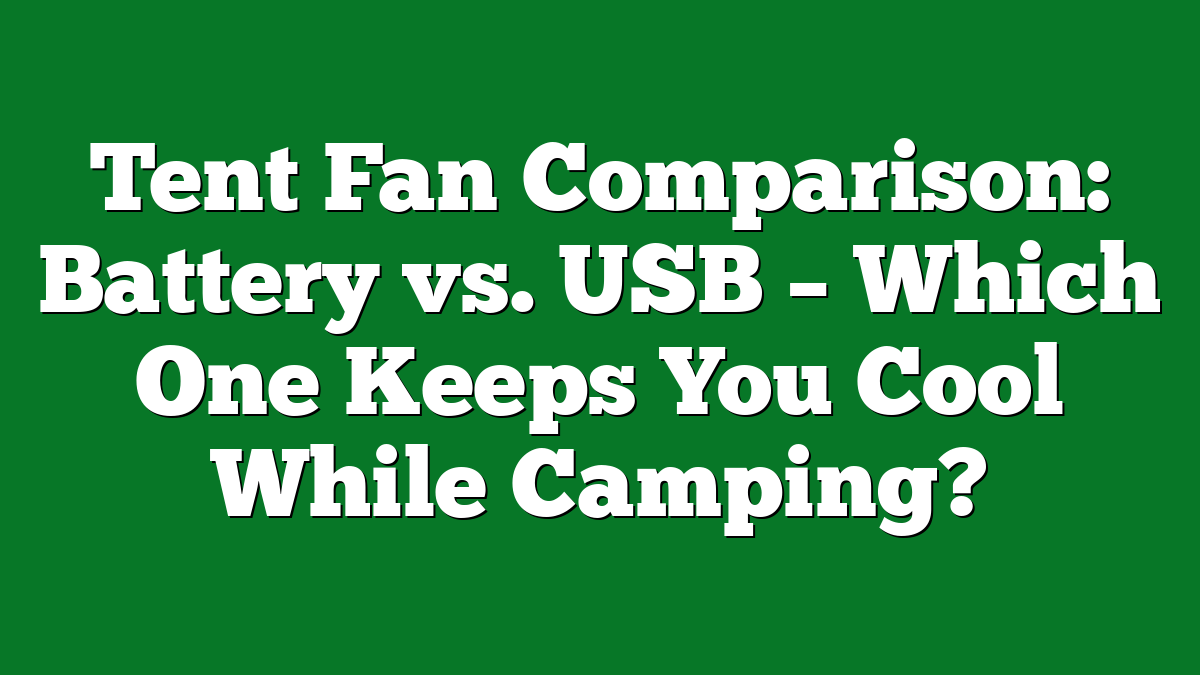When you’re out camping, staying cool can make all the difference. I’ve spent countless nights tossing and turning in a stuffy tent, wishing I had a little breeze to help me sleep. That’s where tent fans come in, and the choice between battery-powered and USB fans can be a game-changer for your outdoor experience.
In this article, I’ll dive into the pros and cons of each type of fan. Whether you’re a weekend warrior or a seasoned camper, understanding the differences can help you make the right choice for your next adventure. Let’s explore how these fans stack up against each other, so you can keep your tent comfy and cool.
Overview of Tent Fans
Tent fans play a crucial role in keeping campers comfortable during hot weather. A good tent fan can make even the muggiest nights more bearable, allowing for better sleep and a more enjoyable camping experience. I often rely on these fans when outdoor temperatures soar, bringing down humidity levels and circulating fresh air.
Battery-powered fans offer the freedom of portability without the need for external power sources. They typically use either rechargeable batteries or standard disposables, allowing for versatility in remote locations. Their performance varies; some can run for many hours on a single charge, while others might only last a few. When choosing a battery fan, consider the fan’s runtime and airflow capacity.
USB fans, on the other hand, connect directly to power banks or solar chargers. They provide consistent power as long as there’s a sufficient supply of electricity. These fans often come with multiple speed settings, making it easy to adjust airflow based on the conditions. When selecting a USB fan, pay attention to the power requirement and ensure it matches your power source capabilities.
Both fan types have their advantages. Battery fans excel in areas without power access, while USB fans shine when you have reliable power options. My choice between the two often depends on the specific campsite and whether I’m fully off-grid or near charging facilities. Each type serves its purpose, ensuring comfort on the trail or around the campfire.
Battery-Powered Tent Fans
Battery-powered tent fans create a refreshing breeze when I’m camping away from power sources. They play a crucial role in keeping the tent cool and comfortable during those sweltering summer nights.
Advantages of Battery Fans
- Portability: Battery fans pack easily into my gear. They can go anywhere, whether I’m in a remote campsite or deep in the woods.
- Versatility: I can use them in various settings. From the tent to sitting around the campfire, they provide a cooling effect wherever needed.
- Quiet Operation: Many battery fans run quietly, allowing for restful sleep without disturbing the campsite’s peaceful ambiance.
- No Power Dependency: They don’t rely on external power. This feature is vital when exploring remote locations with no electricity access.
- Multiple Runtime Options: Many models offer different battery runtimes. Choosing a fan with longer battery life means I can stay cool for extended periods without searching for a power source.
Disadvantages of Battery Fans
- Limited Runtime: Depending on the fan and battery size, they can run out of power. This limitation makes it essential to pack spare batteries or plan battery recharge times.
- Higher Cost of Replacement Batteries: Purchasing replacement batteries can add up quickly, especially for enthusiasts like me who camp frequently.
- Airflow Limitations: While they provide good cooling, their airflow might not match larger, powered fans. This limitation can be a downside on particularly hot nights.
- Weight: Although portable, some models can add unnecessary weight to my pack compared to lighter USB fans.
- Environmental Impact: Regularly disposing of batteries can negatively affect the environment. I always aim to choose rechargeable batteries when possible to mitigate this impact.
USB Tent Fans
USB tent fans offer convenience and reliability for campers who want to beat the heat. These fans connect easily to power banks, solar chargers, or even your vehicle’s USB port, making them a practical choice for those who might not have access to traditional power sources.
Advantages of USB Fans
- Consistent Power Supply: USB fans run continuously as long as they’re plugged into a power source. This guarantees a steady airflow throughout the night.
- Adjustable Speed Settings: Many USB fans feature multiple speed settings, allowing me to customize airflow based on my comfort level and the temperature.
- Lightweight Design: USB fans often weigh less than battery-operated fans, which makes packing them for a camping trip easier.
- Eco-Friendly: Using rechargeable batteries or connecting to solar power reduces environmental impact. I can minimize waste by avoiding disposable batteries.
- Versatile Use: USB fans can be used beyond camping. I often use mine at home or when I’m out fishing, making it a multi-purpose tool.
Disadvantages of USB Fans
- Dependence on Power Sources: USB fans require a consistent power supply to operate, which can be a challenge in remote camping locations without USB outlets.
- Limited Power Bank Capacity: The efficiency of a USB fan relies on the size of the power bank I use. Smaller power banks might not provide enough juice for extended use.
- Reduced Performance in Windy Conditions: In breezy conditions, the effectiveness of a USB fan may diminish, as the ambient wind can compete with its airflow.
- Charging Time: Power banks and solar chargers take time to recharge. I need to plan my power usage and battery charging to ensure my fan operates when needed.
- Fixed Location: Since USB fans must be plugged in, I can’t easily move them once set up, limiting where I can create airflow in my tent.
Choosing between battery and USB fans depends on my camping conditions and power availability. USB fans provide a reliable option when I’m near power sources, ensuring I stay cool and comfortable under the stars.
Performance Comparison
When choosing between battery and USB tent fans, performance plays a crucial role in my comfort and enjoyment while camping. Let’s dive into how both types stack up in terms of battery life, efficiency, airflow, and noise levels.
Battery Life and Efficiency
Battery-powered fans typically offer varying runtimes depending on the fan size and setting. Some high-capacity models run continuously for up to 24 hours on a single charge, while smaller options may last only a few hours. I often carry spare batteries for longer trips to ensure a refreshing breeze throughout the night. Efficiency varies too; some fans are designed for optimal airflow while conserving energy, making them perfect for extended camping trips.
Airflow and Noise Levels
Airflow and noise levels significantly impact my outdoor experience. Battery fans generally provide decent airflow, with many offering different speed settings. However, performance can hit a snag on high-speed settings, causing some to drain batteries quickly. I tend to prefer quieter fans that don’t disturb my fellow campers, especially during peaceful nights. USB fans can sometimes produce stronger airflow due to larger blade sizes and designs but may also generate more noise. Choosing the right fan often means finding a balance between airflow and noise, ensuring comfort without sacrificing tranquility.
Portability and Convenience
Portability and convenience play vital roles when choosing a tent fan for camping. I often prioritize lightweight and compact designs that fit well in my gear without taking up too much space.
Battery-powered fans shine in remote areas where electricity isn’t available. Their independence from external power sources lets me set them up anywhere, providing comfort during those muggy nights. I appreciate models that are easy to carry and can run for several hours on a single charge or with fresh batteries.
USB fans offer a different kind of convenience for campers with access to power banks or solar chargers. They’re typically lightweight and compact, which makes them easy to transport. I value the consistent power supply they provide, especially during long trips where I can recharge them throughout the day.
When planning my camping trips, I think about how I’ll use the fan. Campgrounds with available power often lead me to choose USB fans since they give me added flexibility with their adjustable speed settings. In contrast, during more remote outings, a reliable battery-powered fan ensures I won’t wake up in a sweat from the stifling heat.
Both types have unique advantages. Battery-powered fans grant me the freedom to move around a campsite without worrying about recharging. USB fans bring convenience and reliability when I can connect them to a power source. My choice depends on where I’m going and what kind of camping experience I want.
Conclusion
Choosing between a battery-powered or USB tent fan really comes down to your camping style and needs. I’ve found that battery fans can be a lifesaver in remote spots where power isn’t an option. They’re portable and easy to set up which makes them perfect for those muggy nights under the stars.
On the other hand USB fans are fantastic when you have access to a power source. They offer consistent airflow and adjustable settings which can make a big difference in comfort. No matter which option you pick I hope this comparison helps you stay cool and enjoy your outdoor adventures to the fullest. Happy camping!











